| 1 | Tennis balls for eyes |
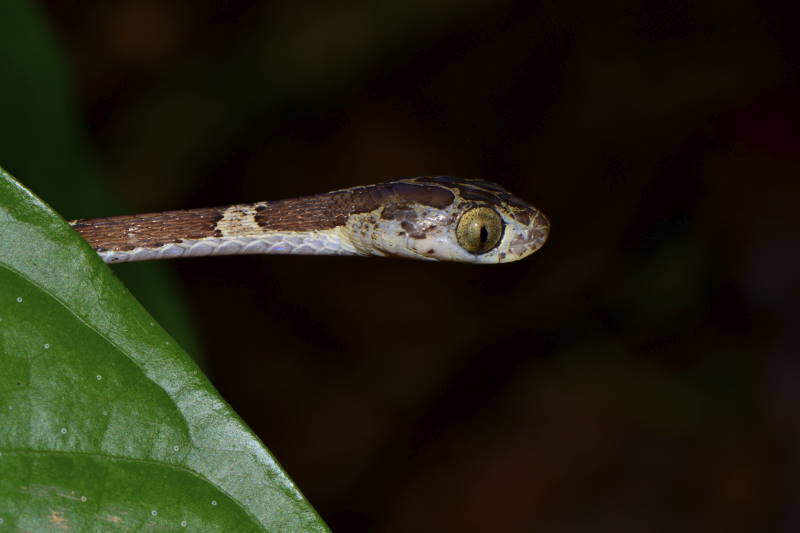
As measured in 1982, the blunt-headed tree snake’s eyes take up 19-34% of its head, and they look even larger when contrasted against its twig-like body. The first purpose is to gaze down at the forest floor, from the branches the species spends much of the day sitting on. The second is binocular vision, the ability to perceive depth created by fields of vision that cross over. In mammals we take this for granted, but most snakes have eyes on the side of their heads, to see their surroundings in poorer quality 2d but give more coverage.
The patterns of their giant eyes are also interesting. The iris is either pale green or pale brown, but some have orange or red speckled irises. A small minority have a brown stripe running down through the pupils. The only thing these eyes lack are glow in the dark capabilities.
| 2 | Binocular vision (rare for a snake) |
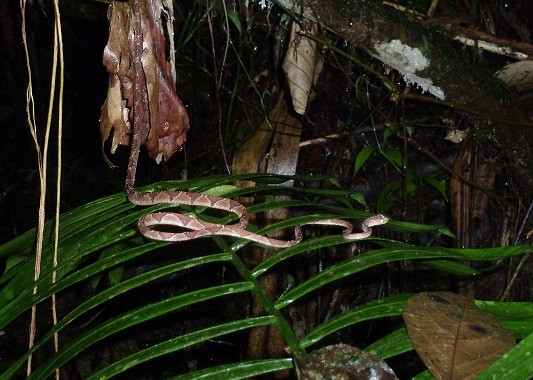
The blunt-headed tree snake is similar to many Amazon snakes in that it’s an arboreal (tree-dwelling) snake. However, it tends to be found in mid-height vegetation much more commonly, and specifically, it coils up inside the core of thick, leafy bromeliad plants.
To picture this family, just imaging the spiralling leaves of a pineapple with its hard base, but on a bigger scale. In fact, pineapples are one species blunthead tree snakes are known to curl up in. Generally though, they prefer the bigger, more bowl like bromeliads. One study found that by day (as this is a nocturnal species), they spend 90% of their time curled up in bromeliad species.
Water is no problem, as bromeliads act as a natural funnel and often accumulate a shallow pool of rainwater. Biologists have even poured water onto a sleeping blunthead tree snake (which are easy to find) and triggered no reaction whatsoever. They’ve also spotted a blunthead tree snake staying perfectly still in a moist bromeliad for 8 days, proving that this can be quite a lazy snake, without matching the puff adder of Africa, possibly the laziest snake ever.
| 3 | Purely nocturnal |
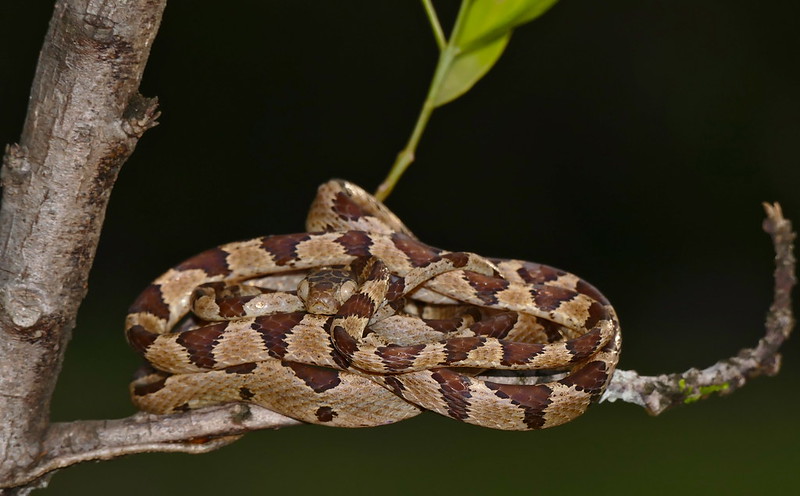
When the sun drops below the horizon, a light flicks on inside this lazy snake’s head. Their first step is the subtle rearranging of their coils, reacting instinctively to fading light. As darkness approaches, they raise their heads several times to gaze around, before returning to their tight coils each time.
Finally, when the cloak of darkness becomes complete, the blunt-headed tree snake leaves its bromeliad base instantly and starts the night’s hunting, moving at top speed from the get go. Imantodes cenchoa is an active forager rather than ambush predator, and consequently is much more adventurous than the average tree snake, usually covering 5-10 metres in 1 minute.
Rather than chasing down prey at breakneck speeds, blunt-headed tree snakes spring at them from s-shaped coils. Then they grip their prize and inject a mild venom using rear fangs at the back of their jaws, venom which is far too weak to kill a human but works well for small lizards. Rather than retreating to a safe watching distance, Imantodes cenchoa holds the prey in its jaws until it finally stops twitching.
| 4 | Everywhere in South America |
Imantodes cenchoa has no idea what the word endangered means, as its range is one of the largest of any South American snake. It can be found in over a dozen countries, in rainforests and secondary forests alike. The northernmost tip of its range lies in Mexico while the southernmost point lies in northern Argentina. Its vast territories between include Brazil, Columbia, Venezuela, Paraguay, and Bolivia (but not Chile). It’s fundamentally a snake of the forests rather than fields or rocky canyon, but is more likely to be found in primary rainforest rather than cloud forests. It can be found up to altitudes of 1800 metres, down to sea level.
Across its huge range, the blunt-headed tree snake barely varies in appearance. Very few unique colours, larger versions, or subtly shifting body shapes have evolved, despite the huge amount of separate populations. The only slight differences are in sexual dimorphism between the northern and southern populations. In some areas, females have significantly larger heads compared to males, while northern males have significantly longer tails compared to southern males.
| 5 | Other ID signs |
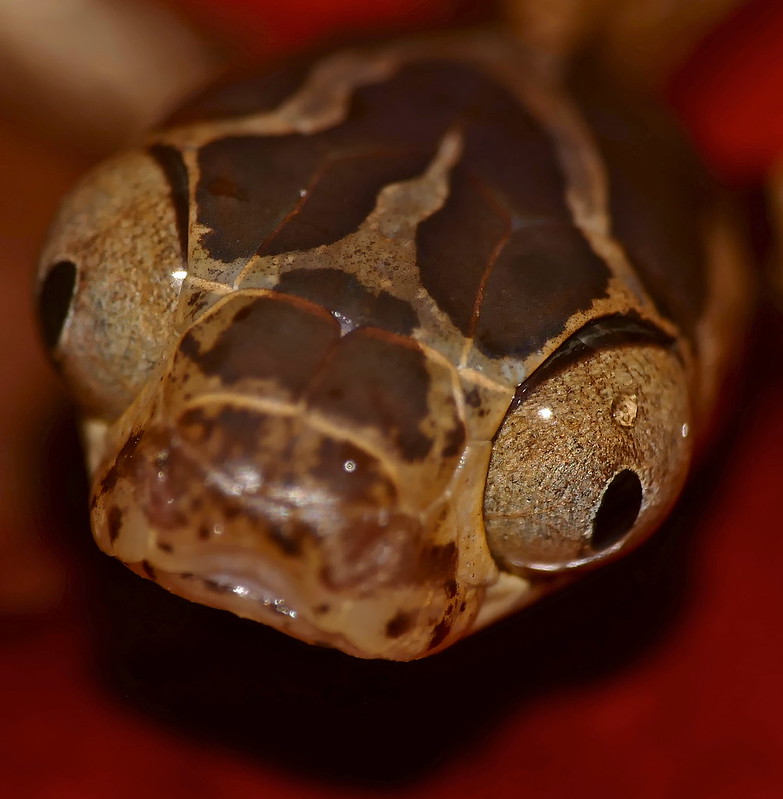
The orb-like eyes are the easiest way to spot a blunt-headed tree snake, but another tactic is to examine the neck. Its body is very thin, which makes crossing branches incredibly easy. The neck is particularly thin, but the head thickens massively, so that a single eye appears to be wider then the neck’s thinnest point.
This isn’t the longest species of snake, measuring 80cm on average with the largest females reaching 100cm. The mid-section is its thickest point, but the tail is also incredibly thin, so thin that it looks like it would snap if it tried to grip anything.
This snake has a beige and brown pattern, with irregular splodges of brown covering its thin body and beige being the underscales. However, these paler scales can sometimes have orange tinges. Likewise, the brown splodges are sometimes almost black. Its head is pale on the underside and its belly is the same colour as its paler scales: usually beige or yellow. The tongue also varies in colour. It can be light grey, dark grey or sometimes brown. It’s rare for this snake to be fabulously colourful – it’s all about the mesmerising eyes.
| 6 | Diet: lizards and anoles |
This species has the opposite of a varied diet, and more importantly, it doesn’t care. Instead, blunt-headed tree snakes eat a neverending stream of Amazon lizards, particularly members of the anole family. One is the border anole (Anolis limifrons), a widespread 4.5cm lizard with a pale green-brown colour. Another is the 8cm pug-faced anole (anolis capito), which is far thicker and mainly found in Central American countries like Mexico and Panama.
Females are able to eat much larger anoles such as the 14cm bridled anole (Anolis frenatus), because their heads are comparatively larger than males. Imantodes cenchoa are disgusted by the taste of toads, and regurgitate them whenever they try to eat one. They almost never eat mammals, staying away from the rice rats which emerald tree boas eat for their daily fill.
Insects were found in their stomachs in a 1993 study, but it’s believed that these were insects which the anoles had eaten, before being eaten themselves, in the ultimate circle of life. The next stage could be the snake being eaten by an eagle.
| 7 | Zooms in on sleeping lizards |
This taste for anoles is partly why the species is a nocturnal snake, as anoles rest and recuperate during the day. Blunt-headed tree snakes like to sneak up on the anoles as they sleep on top of green vegetation, but can also hunt awake and active anoles running along branches. Other snakes rely on the flicker of movement to take notice, but one imantodes cenchoa spotted and swallowed an anole which had been stationary for 93 minutes. Their huge eyes might have something to do with this skill.
After eating these anoles, a blunt-headed tree snake can sometimes go 15 days without moving, digesting its prey slowly but surely. All imantodes cenchoa specimens observed in the wild have swallowed their prey headfirst, joining the likes of Asian vine snakes and eastern coral snakes.
Being adventurous has negative consequences as well, as blunt-headed tree snakes are sometimes found dead on forest roads with tyre marks on their backs. This is almost unheard of for the lazy emerald tree boa.
| 8 | Navigates super-thin branches |
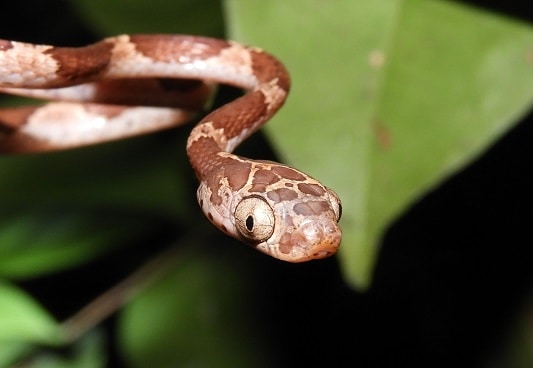
Few snakes could cope with the blunt-headed lifestyle, no matter how much they wanted it. Their bodies are too bulky, their scales are too smooth, and they lack the instincts for crossing branches with supremely accurate judgement. Imantodes cenchoa has many such adaptions, starting with an enlarged row of mid-dorsal scales. This provides stability when climbing branches, allowing them to dig in similarly to the corn snake.
The bulbous eyes are another tree-dwelling adaption, as it allows them to direct their gaze downwards. Their entire body shape has shifted and evolved, so that the imantodes family is compressed at the sides, making it longer, but without adding weight. This allows the blunt-headed tree snake to cross spaces between branches approximately 50% of its own body length, compared to oxybelis or leptophis, which weigh the branches down with their heaviness.
Imantodes cenchoa also has laterally (sideways) projecting shelves on each vertebrae of its spinal column, creating more stability on the branches. This is common in tree-dwelling snakes, but the imantodes family has the longest shelves of all.
| 9 | A peaceful neighbour |
Blunt-headed tree snakes are also known to take refuge in coffee trees, being a common crop all over South America. Bromeliads are their favourite lairs of all, but they’re also pragmatic, and are sometimes found beneath two large overlapping leaves to shield them from view of predators. More rarely, they can be found beneath leaf litter or inside a rotting leg.
Though a tree-dwelling species, imantodes cenchoa drops to the ground much more commonly than the nearby emerald tree boa, and have been spotted sleeping at the base of thick palm trees. If they do take the leaf litter route, then they normally bury their bodies utterly and completely, being paranoid when they’re away from their usual lairs.
Imantodes cenchoa is a relatively peaceful snake, as it’s common for two to share the same bromeliad without conflict. They’ve also been witnessed sharing bromeliads with frogs of the hyla family. This peacefulness carries over to its interactions with humans. This isn’t a bloodthirsty constrictor, as they rarely bite when approached. They rarely flee from their bromeliads at all, barely reacting to a camera-wielding interloper.
| 10 | Drinks water from its own scales |
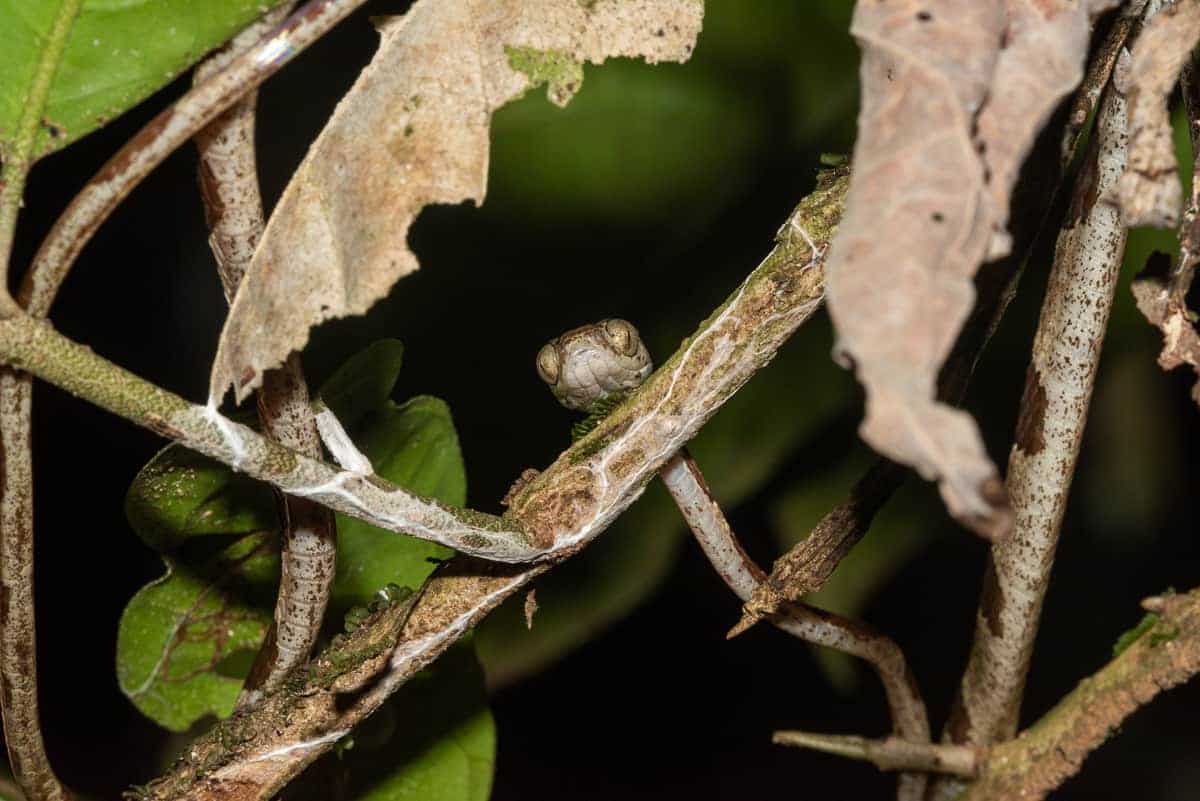
In the parched, blazing deserts of Arizona, the western diamondback rattlesnake has ingenious methods of surviving against all odds. Scientists discovered in 2019 how it senses an approaching rainstorm, slithers out of its sun shelter and flattens its body in order to collect drops of rainwater. The grooves of its scales are expertly designed to catch these droplets on a nanomolecular level. Afterwards, the rattlesnake sucks the water up through its mouth like a straw, as unlike dogs, snakes lack the ability to lick up water.
This adaption makes sense in a desert, but the rainforest-dwelling imantoads cenchoa is also known to drink beaded water on its scales, joining its fellow tree snakes Leptodeira and Trimeresurus. This trick may have evolved to prevent constant excursions to the forest floor in which they might waste energy.
Another trick is hanging from a nearby bush with its tail, and sucking up water from a nearby pool. In other instances, they’ll drink rainwater as it steadily accumulates in the bromeliad where they’re coiled up, or beads of water sitting on leaf surfaces.
